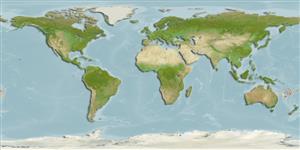分类 / Names
俗名 | 同种异名 | Catalog of Fishes(属, 种) | ITIS | CoL | WoRMS | Cloffa
Teleostei >
Pleuronectiformes (Flatfishes) >
Poecilopsettidae (Bigeye flounders)
Etymology: Poecilopsetta: Greek, poikilos = with a lot of colours + Greek, psetta = grouper (Ref. 45335); multiradiata: This new species is named from the Latin multus (numerous) and radius (rays) in reference to its high number of dorsal fin rays (Ref. 84061).
Environment: milieu / climate zone / depth range / distribution range
生态学
海洋 深海底的; 深度上下限 336 - 480 m (Ref. 84061). ; 18°S - 28°S, 163°W - 173°W
分布
国家 | FAO区域 | 生态系 | 标本纪录 | Point map | 简介 | Faunafri
Pacific Ocean: New Caledonia and New Zealand (Ref. 84061).
大小 / 重量 / 年龄
Maturity: Lm ? range ? - ? cm
Max length : 155 cm SL 雄鱼/尚未辨别雌雄; (Ref. 84061); 16.5 cm SL (female)
简单描述
型态特徵 | 形态测量图
A species of the genus Poecilopsetta with the following combination of characters: high number of dorsal (70–73) and anal (58–62) fin rays, ca. 85–99 lateral-line scales, 31–32 caudal vertebrae, and relatively shallow body depth (36.9–41.9% SL).
Body compressed and elliptical. Head small and compressed. Snout short. Ocular-side anterior nostril a short tube situated on snout anterior to lower eye on the horizontal through middle of lower eye; ocular-side posterior nostril very short tube situated at anterior margin of interorbital space. Eyes dextral and small, separated by narrow bony ridge. Mouth small and oblique, maxilla extending to point between verticals through anterior margin of pupil and mid-point of lower eye; tip of lower jaw with very small symphyseal knob; lower jaw extending to vertical through middle of lower eye; band of small teeth on each jaw, tooth bands on blind-side jaws more developed than those on ocular-side jaws. Vomer and palatines toothless. Gill rakers on first arch not serrated, and slender on both limbs. Gill membranes united.
Scales very small and deciduous; ctenoid on ocular side, cycloid on blind side. Eyes, both jaws, and snout from tip to anterior interorbital region scaleless. Lateral line on ocular side strongly curved above pectoral fin; lateral line absent on blind side.
Dorsal fin origin on blind side of head at point equal to vertical through middle of upper eye. Anal fin origin posterior to anus on mid-ventral line. All dorsal fin rays, except for first ray, and all anal fin rays simple. First dorsal fin ray usually branched (simple in MNHN 2008-2207 and 2008-2208). Pectoral fin on both sides small; anterior 3 (2–3) rays on ocular side and all rays on blind-side fin simple. Pelvic fins small, first ray on blind-side fin opposite third ray of ocular-side fin; all ocular-side pelvic fin rays usually branched (all unbranched in MNHN 2008-2208), posterior 4 (0–4) rays branched in blind-side pelvic fin. Caudal fin rounded, inner 14 (15 in MNHN 1994-0814) rays branched, other rays simple. Anus on mid-ventral line. Urogenital papilla very small, located on ocular side slightly dorsal to anus (Ref. 84061).
Life cycle and mating behavior
成熟度 | 繁殖 | 产卵场 | 卵 | 孕卵数 | 仔鱼
Kawai, T., K. Amaoka and B. Séret, 2010. A new righteye flounder, Poecilopsetta multiradiata (Teleostei: Pleuronectiformes: Poecilopsettidae), from New Zealand and New Caledonia (South-West Pacific). Ichthyol. Res. 57:193-198. (Ref. 84061)
人类利用
更多信息
国家FAO区域生态系标本纪录简介Stocks生态学食性食物相食物消耗量定量
俗名同种异名新陈代谢捕食者生态毒物学繁殖成熟度产卵场产卵群集孕卵数卵卵的发育
年龄范围成长体长-体重体长-体长体长-频率形态测量图型态特徵仔鱼稚鱼动力学入添量丰度BRUVS
参考文献养殖养殖信息品种遗传学Electrophoreses遗传率疾病加工NutrientsMass conversion
合作者照片Stamps, Coins Misc.声音神经毒速度泳型鳃区Otoliths脑重体重比眼睛色素
工具
特别资料
下载 XML
网络资源
Estimates based on models
Preferred temperature (Ref.
123201): 3.1 - 6.5, mean 4.5 °C (based on 67 cells).
Phylogenetic diversity index (Ref.
82804): PD
50 = 0.5000 [Uniqueness, from 0.5 = low to 2.0 = high].
Bayesian length-weight: a=0.01995 (0.00906 - 0.04395), b=3.01 (2.83 - 3.19), in cm total length, based on all LWR estimates for this body shape (Ref.
93245).
营养阶层 (Ref.
69278): 4.1 ±0.5 se; based on size and trophs of closest relatives
Fishing Vulnerability (Ref.
59153): Very high vulnerability (90 of 100).
